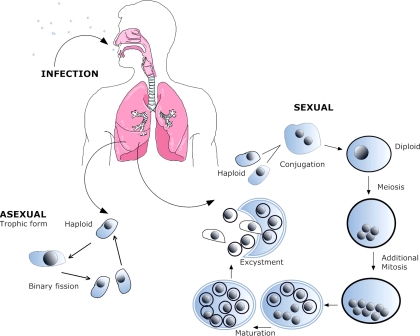FIG. 3.
Putative life cycle of Pneumocystis. (i) Infection. The agent of infection is suspected to be airborne spores, but these have not been identified. (ii) Asexual phase. Haploid trophic forms replicate asexually by binary fission. (iii) Sexual phase. Two presumptive mating types conjugate, undergo karyogamy, and produce a diploid zygote, which progresses through meiosis and then an additional mitosis to produce eight nuclei. The nuclei are packaged into spores by invagination of the ascus cell membranes. After completion, excystment occurs via protunicate release by unknown mechanisms. The released spores become the vegetative forms that can then undergo asexual or sexual replication.

